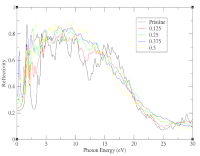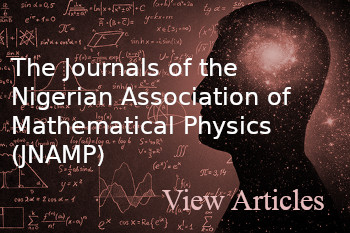EFFECTS OF SULPHUR DOPING ON PROPERTIES OF CoO FOR VARIOUS APPLICATIONS: A DFT+U STUDY.
DOI:
https://doi.org/10.60787/tnamp.v20.379Keywords:
Sulphur-doped CoO, DFT+U, Electronic structure, Optical properties, AntiferromagnetismAbstract
Transition metal oxides have been tipped for versatile applications owing to the flexibility of their properties based on doping and prevailing experimental conditions. In this study, the electronic, optical, and magnetic properties of sulphur-doped cobalt oxide, CoO1-xSx (x = 0.125, 0.25, 0.375, and 0.5) was studied using density functional theory (DFT) and its Hubbard U modified variant (DFT+U). Electronic structure analysis showed notable changes in the electronic energy structure as the dopant concentration increases. Our result showed that the significant effect of doping CoO with sulphur is the lowering of the electronic energy gap to a size which enhances absorption in the visible regime of the solar energy for efficient photovoltaic and other applications. Investigation of the magnetic properties showed that CoO1-xSx exists in antiferromagnetic ground state. Our studies provide useful insights into the mechanism for enhancing the performance of CoO through non-metal doping for photovoltaic and other applications.
Downloads
References
U. D. Wdowik and K. Parlinski, “Lattice dynamics of CoO from first principles,” Phys Rev B Condens Matter Mater Phys, vol. 75, no. 10, Mar. 2007, doi: 10.1103/PhysRevB.75.104306.
S. O. Aisida et al., “Microstructural and magneto-optical properties of Co1-xNix Fe2O4 nanocomposites for hyperthermia applications,” Solid State Sci, vol. 136, Feb. 2023, doi: 10.1016/j.solidstatesciences.2022.107107.
K. O. Egbo, T. C. Chibueze, A. T. Raji, C. E. Ekuma, C. P. Liu, and K. M. Yu, “Effects of acceptor doping and oxygen stoichiometry on the properties of sputter-deposited p-type rocksalt NixZn1-xO (0.3≤x≤1.0) alloys,” J Alloys Compd, vol. 905, Jun. 2022, doi: 10.1016/j.jallcom.2022.164224.
T. C. Chibueze and C. M. I. Okoye, “First principles study of the structural, electronic and magnetic properties of w-CoS,” Physica B Condens Matter, vol. 554, pp. 165–172, Feb. 2019, doi: 10.1016/j.physb.2018.11.019.
C. Zheng, C. Cao, Z. Ali, and J. Hou, “Enhanced electrochemical performance of ball milled CoO for supercapacitor applications,” J Mater Chem A Mater, vol. 2, no. 39, pp. 16467–16473, Oct. 2014, doi: 10.1039/c4ta02885f.
Q. Zhang, Z. Jin, F. Li, Z. Xia, Y. Yang, and L. Xu, “First application of CoO nanorods as efficient counter electrode for quantum dots-sensitized solar cells,” Solar Energy Materials and Solar Cells, vol. 206, Mar. 2020, doi: 10.1016/j.solmat.2019.110307.
W. S. Seo, J. H. Shim, S. J. Oh, E. K. Lee, N. H. Hur, and J. T. Park, “Phase- and size-controlled synthesis of hexagonal and cubic CoO nanocrystals,” J Am Chem Soc, vol. 127, no. 17, pp. 6188–6189, May 2005, doi: 10.1021/ja050359t.
S. Grytsyuk and U. Schwingenschlögl, “Mechanism of magnetization enhancement at CoO/permalloy interfaces,” Appl Phys Lett, vol. 103, no. 7, Aug. 2013, doi: 10.1063/1.4818507.
U. D. Wdowik and K. Parlinski, “Electronic structure of cation-deficient CoO from first principles,” Phys Rev B Condens Matter Mater Phys, vol. 77, no. 11, Mar. 2008, doi: 10.1103/PhysRevB.77.115110.
S. N. F. Moridon, K. Arifin, A. Linggawati, L. J. Minggu, and M. Bin Kassim, “Density Functional Theory Study on the Electronic Properties of Doped-Cobalt Oxide (CoO),” Jurnal Kejuruteraan, vol. 32, no. 1, pp. 61–66, Feb. 2020, doi: 10.17576/jkukm-2020-32(1)-08.
B. Zhou, X. Zhao, H. Liu, J. Qu, and C. P. Huang, “Visible-light sensitive cobalt-doped BiVO4 (Co-BiVO4) photocatalytic composites for the degradation of methylene blue dye in dilute aqueous solutions,” Appl Catal B, vol. 99, no. 1–2, pp. 214–221, Aug. 2010, doi: 10.1016/j.apcatb.2010.06.022.
S. Grytsyuk and U. Schwingenschlögl, “Mechanism of magnetization enhancement at CoO/permalloy interfaces,” Appl Phys Lett, vol. 103, no. 7, Aug. 2013, doi: 10.1063/1.4818507.
X. Feng et al., “Converting ceria polyhedral nanoparticles into single-crystal nanospheres,” Science (1979), vol. 312, no. 5779, pp. 1504–1508, Jun. 2006, doi: 10.1126/science.1125767.
M. Y. Yin, X. C. Wang, W. B. Mi, Y. H. Ding, G. F. Chen, and B. H. Yang, “Magnetism and electronic structure in Zn and Ti doped CoO: A first-principles study,” Comput Mater Sci, vol. 93, pp. 193–200, 2014, doi: 10.1016/j.commatsci.2014.06.016.
R. X. Liu, X. C. Wang, G. F. Chen, and B. H. Yang, “Magnetism and electronic structure in La-doped CoO: A first-principles study,” Physica E Low Dimens Syst Nanostruct, vol. 74, pp. 226–232, Jul. 2015, doi: 10.1016/j.physe.2015.07.008.
R. X. Liu, X. C. Wang, G. F. Chen, and B. H. Yang, “First-principles study on the magnetism and electronic structure in 3d transition metal (X=Sc, V, Cr, Mn, Fe, Ni, Cu) doped CoO,” Physica E Low Dimens Syst Nanostruct, vol. 77, pp. 149–155, Mar. 2016, doi: 10.1016/j.physe.2015.11.022.
C. Chen et al., “Controllable synthesis of Cu-doped CoO hierarchical structure for high performance lithium-ion battery,” J Power Sources, vol. 314, pp. 66–75, May 2016, doi: 10.1016/j.jpowsour.2016.02.085.
Y. J. Li et al., “Multiscale Structural Engineering of Ni-Doped CoO Nanosheets for Zinc–Air Batteries with High Power Density,” Advanced Materials, vol. 30, no. 46, Nov. 2018, doi: 10.1002/adma.201804653.
A. Van De Walle, " M Asta, and G. Cederb, “The Alloy Theoretic Automated Toolkit: A User Guide,” 2002.
I. E. Gaa, P. Hohenbergt Ecole, X. Superzeure, I’aris, F. And, and W. Konnt, “PHYSICAL REVIEW.”
W. Kohn and L. J. Sham, “PHYSICAL REVIEW Self-Consistent Equations Including Exchange and Correlation Effects*.”
P. Giannozzi et al., “QUANTUM ESPRESSO: A modular and open-source software project for quantum simulations of materials,” Journal of Physics Condensed Matter, vol. 21, no. 39, 2009, doi: 10.1088/0953-8984/21/39/395502.
“physrevlett.43.1494 j”.
H. J. Monkhorst~, “Hartree-Fock density of states for extended systems.”
S. Rodríguez, C. Zandalazini, J. Navarro, K. T. Vadiraj, and E. A. Albanesi, “First principles calculations and experimental study of the optical properties of Ni-doped ZnS,” Mater Res Express, vol. 7, no. 1, 2019, doi: 10.1088/2053-1591/ab5cd2.
S. L. Dudarev, G. A. Botton, S. Y. Savrasov, C. J. Humphreys, and A. P. Sutton, “Electron-energy-loss spectra and the structural stability of nickel oxide: An LSDAU study,” 1998.
I. Timrov, N. Marzari, and M. Cococcioni, “Hubbard parameters from density-functional perturbation theory,” Phys Rev B, vol. 98, no. 8, Aug. 2018, doi: 10.1103/PhysRevB.98.085127.
I. Timrov, N. Marzari, and M. Cococcioni, “Self-consistent Hubbard parameters from density-functional perturbation theory in the ultrasoft and projector-augmented wave formulations,” Phys Rev B, vol. 103, no. 4, Jan. 2021, doi: 10.1103/PhysRevB.103.045141.
F. Tran, P. Blaha, K. Schwarz, and P. Novák, “Hybrid exchange-correlation energy functionals for strongly correlated electrons: Applications to transition-metal monoxides,” Phys Rev B Condens Matter Mater Phys, vol. 74, no. 15, 2006, doi: 10.1103/PhysRevB.74.155108.
G. Fischer et al., “Exchange coupling in transition metal monoxides: Electronic structure calculations,” Phys Rev B Condens Matter Mater Phys, vol. 80, no. 1, Aug. 2009, doi: 10.1103/PhysRevB.80.014408.
E. Z. Kurmaev, R. G. Wilks, A. Moewes, L. D. Finkelstein, S. N. Shamin, and J. Kuneš, “Oxygen x-ray emission and absorption spectra as a probe of the electronic structure of strongly correlated oxides,” Phys Rev B Condens Matter Mater Phys, vol. 77, no. 16, Apr. 2008, doi: 10.1103/PhysRevB.77.165127.
P. De, V. Du Plessiss, S. J. Van Tonder, and L. Alberts, “Elastic constants of a NiO single crystal: I (Magnetic transitions) Elastic constants of’a NiO single crystal: It,” 1971. [Online]. Available: http://iopscience.iop.org/0022-3719/4/14/013
N. Tuan Hung, A. R. T Nugraha, and R. Saito, “Quantum ESPRESSO Course for Solid‐State Physics.indd.”
A. Taya, P. Rani, J. Thakur, and M. K. Kashyap, “First principles study of structural, electronic and optical properties of Cs-doped CH3NH3PbI3 for photovoltaic applications,” Vacuum, vol. 160, pp. 440–444, Feb. 2019, doi: 10.1016/j.vacuum.2018.12.008.
M. Khuili, N. Fazouan, H. Abou El Makarim, E. H. Atmani, D. P. Rai, and M. Houmad, “First-principles calculations of rare earth (RE=Tm, Yb, Ce) doped ZnO: Structural, optoelectronic, magnetic, and electrical properties,” Vacuum, vol. 181, Nov. 2020, doi: 10.1016/j.vacuum.2020.109603.

Downloads
Published
Issue
Section
License
Copyright (c) 2024 The Transactions of the Nigerian Association of Mathematical Physics

This work is licensed under a Creative Commons Attribution-NonCommercial 4.0 International License.




